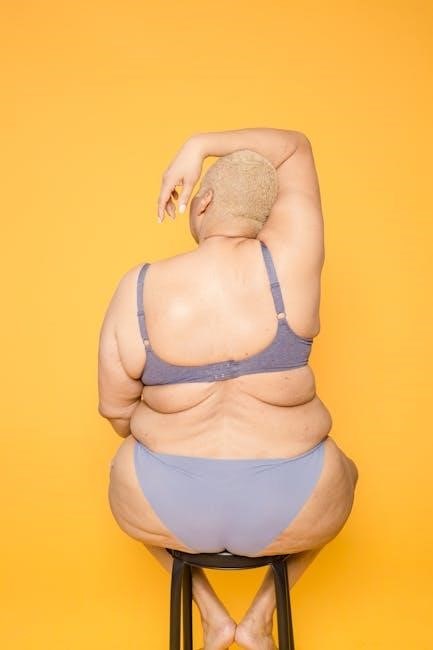Welcome to the ultimate guide for finding your perfect fit in men’s underwear․ Proper sizing ensures comfort‚ confidence‚ and all-day support․ With varying brand standards and styles‚ this guide helps you navigate size charts‚ measurements‚ and fit considerations to make informed choices․
Discover how to measure accurately‚ understand fabric impact‚ and address common fit issues․ Whether you prefer briefs‚ boxers‚ or thongs‚ this guide simplifies the process to ensure your underwear fits perfectly every time․
1․1 Importance of Proper Fit in Men’s Underwear
A proper fit in men’s underwear is essential for comfort‚ confidence‚ and overall well-being․ Ill-fitting underwear can lead to discomfort‚ chafing‚ or restricted movement‚ affecting daily activities․ It can also cause health issues like rashes or skin irritation․ Properly fitted underwear supports your body‚ enhances mobility‚ and boosts hygiene․ Choosing the right size ensures optimal support and prevents issues like ride-up or sagging․ A well-fitting pair is key to feeling your best throughout the day‚ making it a foundational aspect of your wardrobe․
1․2 Common Challenges in Finding the Right Size
Finding the right size in men’s underwear can be challenging due to inconsistent sizing across brands and styles․ Varying measurements for waist‚ hips‚ and inseam often lead to confusion․ Additionally‚ different styles like thongs or high-waisted briefs fit differently‚ requiring careful consideration․ Many men struggle with improper fit due to not measuring accurately or ignoring brand-specific size charts․ Fabric stretch and personal comfort preferences further complicate the process․ To overcome these challenges‚ precise measurements and consulting brand guides are essential for achieving the perfect fit․

Understanding Men’s Underwear Size Charts
Mens underwear size charts vary by brand and style‚ focusing on waist and hip measurements․ Consulting brand-specific charts ensures accurate fit and comfort․
2․1 Standard Size Categories (S‚ M‚ L‚ XL)
Standard size categories for men’s underwear include Small (S)‚ Medium (M)‚ Large (L)‚ and Extra Large (XL)‚ with some brands offering XXL or XXXL․ These categories provide a general fit guide based on body measurements‚ ensuring comfort and support․ However‚ sizing can vary between brands‚ so it’s essential to refer to specific size charts․ These categories help consumers quickly identify their size range‚ making the selection process simpler and more efficient․ Accurate measurements are key to finding the best fit within these standard categories․
2․2 Measurement Parameters: Waist‚ Hips‚ and Inseam
When determining men’s underwear size‚ key measurements include waist‚ hips‚ and inseam․ The waist is measured around the natural waistline‚ typically just above the hipbone․ Hips are measured around the widest part of the pelvis‚ about 7-9 inches below the waist․ Inseam refers to the length of the underwear‚ measured from the crotch to the bottom of the leg․ These measurements help ensure a comfortable and supportive fit‚ with waist size being the most critical for underwear sizing․ Accurate measurements are essential for selecting the right size․
2․3 How to Read a Size Chart
Reading a men’s underwear size chart involves matching your measurements to the provided size ranges․ Typically‚ charts list sizes like Small‚ Medium‚ and Large‚ with corresponding waist measurements in inches or centimeters․ For example‚ a Medium might fit a 32-34 inch waist․ Ensure you’re using the correct chart for your underwear style‚ as fit can vary between briefs‚ boxers‚ and trunks․ Measure yourself accurately‚ considering waist‚ hips‚ and inseam․ If your measurements fall between sizes‚ choose based on comfort preference․ Some charts offer guidance on sizing decisions and fabric considerations‚ helping you select the best fit for comfort and support․

How to Measure Yourself for the Perfect Fit
Measuring yourself accurately ensures a comfortable and supportive fit․ Use a flexible tape measure‚ keep it level‚ and maintain a relaxed posture during measurements․
3․1 Measuring Your Waist Accurately
To measure your waist accurately‚ locate the narrowest part of your torso‚ typically just above the hipbone and below the ribcage․ Use a flexible tape measure‚ ensuring it is level and not too tight or loose․ Stand upright with feet shoulder-width apart and relax your stomach․ Wrap the tape measure around your natural waistline‚ keeping it parallel to the floor․ Take note of the measurement without inhaling deeply‚ as this can alter the size․ This ensures the best fit for your underwear․
3․2 Measuring Your Hips for the Best Fit

To measure your hips accurately‚ stand upright and place the tape measure around the widest part of your hips‚ approximately 7-9 inches below your waistline․ Ensure the tape is level and not too tight or loose․ Keep your feet shoulder-width apart and relax your posture․ This measurement helps determine the best fit for underwear styles that provide hip coverage‚ ensuring comfort and support․ Accurate hip measurement is crucial for avoiding overly tight or loose-fitting underwear․
3․3 Understanding Inseam and Its Role in Fit
The inseam in men’s underwear refers to the length of the garment from the top of the inner thigh to the bottom of the crotch․ It plays a crucial role in ensuring comfort and preventing issues like chafing or restrictive movement․ A longer inseam offers more coverage and support‚ while a shorter one provides a sleeker fit․ To measure accurately‚ stand upright and measure from the top of your inner thigh down to where the underwear would naturally rest․ Proper inseam ensures optimal comfort and mobility throughout the day․
Different Styles of Men’s Underwear
Men’s underwear comes in various styles‚ each offering unique comfort‚ support‚ and aesthetic appeal․ Common styles include briefs‚ boxers‚ trunks‚ thongs‚ and high-waisted briefs‚ catering to diverse preferences and needs․

4․1 Briefs‚ Boxers‚ and Trunks: Fit Differences
Briefs provide a snug‚ supportive fit with a low-rise waistband‚ ideal for active lifestyles․ Boxers offer a looser fit with a longer inseam‚ prioritizing comfort and breathability․ Trunks combine elements of both‚ featuring a mid-rise waist and shorter inseam for a modern‚ streamlined look․ Each style caters to different preferences‚ with briefs emphasizing support‚ boxers focusing on relaxation‚ and trunks balancing comfort and aesthetics․ Understanding these fit differences helps in selecting the most suitable style for individual needs and activities․
4․2 Thongs and Low-Rise Underwear: Unique Fit Considerations
Thongs and low-rise underwear offer minimal coverage‚ emphasizing comfort and style․ Thongs feature a narrow strap between the buttocks‚ reducing visible lines‚ while low-rise styles sit below the natural waistline․ Fit considerations include waistband elasticity‚ leg opening comfort‚ and strap width․ These styles prioritize breathability and lightweight fabric‚ making them ideal for specific occasions․ Proper sizing ensures the waistband stays in place without digging‚ and the material should be soft to avoid irritation․ These options cater to those seeking a modern‚ sleek look with unique fit needs․
4․3 High-Waisted Briefs: How They Differ in Sizing
High-waisted briefs offer a unique fit due to their extended waistband‚ providing additional coverage and support․ Unlike standard briefs‚ they sit higher on the torso‚ often reaching the natural waistline․ Sizing focuses on both waist and hip measurements to ensure a secure‚ comfortable fit․ The higher rise can affect how the fabric stretches‚ requiring precise sizing to avoid tightness or gapping․ This style is ideal for those seeking enhanced support and coverage‚ with sizing tailored to accommodate the longer waistband design while maintaining overall comfort and mobility․

Brand-Specific Sizing Variations
Brands often have unique sizing standards‚ reflecting their target audience and design philosophy․ Differences in cut‚ fabric‚ and fit mean sizes can vary significantly between brands․
5․1 Why Sizing Varies Between Brands

Different brands often have unique sizing standards due to variations in design‚ target audience‚ and fabric choices․ Some brands cater to specific body types or preferences‚ such as athletic builds or comfort-focused designs․ Additionally‚ manufacturing processes and material quality can influence how sizes are defined․ Fit preferences‚ like snug or relaxed‚ also differ between brands․ Understanding these differences is crucial for selecting the right size‚ as what fits well in one brand may not in another․ Always check the brand’s size chart for accurate measurements․
5․2 Importance of Checking the Brand’s Size Chart
Checking a brand’s size chart is essential because every brand has different measurements and fit standards․ Even if you know your usual size‚ variations in design‚ fabric‚ and cut can affect how underwear fits․ Body type‚ muscle distribution‚ and personal fit preferences also influence sizing across brands․ Ignoring the chart may result in underwear that’s too tight‚ too loose‚ or uncomfortable․ Take a moment to review the chart to ensure the best fit and avoid returns or exchanges for optimal comfort and satisfaction․
5․3 Popular Brands and Their Sizing Differences
Popular brands like Calvin Klein‚ Tommy Hilfiger‚ and Hanes often have distinct sizing approaches․ Calvin Klein tends to run slightly smaller‚ favoring a snug fit‚ while Tommy Hilfiger leans toward a more relaxed cut․ Hanes typically offers consistent sizing but may vary depending on the collection․ These differences highlight the need to compare sizes across brands․ Always refer to the specific brand’s chart to ensure accuracy․ Experimenting with different brands can help you discover the perfect fit for your comfort and style preferences․
Tips for Choosing the Right Size

Always consider your body type‚ fabric preferences‚ and activity level․ Ensure a comfortable fit by leaving room for movement․ Prioritize breathability and support based on your lifestyle․
6․1 Considering Your Body Type
Your body type plays a crucial role in selecting the right underwear size․ Slim builds may prefer trim cuts‚ while athletic builds might opt for supportive styles․ Larger frames benefit from roomier designs․ Pay attention to how fabric drapes and fits naturally without constriction․ For muscular torsos‚ ensure the waistband sits comfortably without digging in․ If you have longer legs‚ consider inseam length for comfort․ Balancing your body proportions ensures optimal comfort and support‚ making it easier to move confidently throughout the day․
6․2 Fabric Type and How It Affects Fit
Fabric type significantly impacts the fit and comfort of men’s underwear․ Cotton offers breathability and softness‚ ideal for everyday wear‚ while polyester blends provide durability and moisture-wicking properties‚ perfect for active lifestyles․ Bamboo and modal fabrics are known for their softness and stretch‚ offering a snug yet comfortable fit․ Thicker fabrics may provide more support but can feel restrictive‚ while thinner ones offer lightweight comfort․ Choosing the right fabric ensures a balance between support‚ breathability‚ and flexibility‚ enhancing overall fit and wearer satisfaction․
6․3 Allowing for a Comfortable Fit
Achieving a comfortable fit involves ensuring your underwear isn’t too tight or restrictive․ Opt for a waistband that feels snug but doesn’t dig into your skin‚ allowing for a full range of motion․ Consider your lifestyle—more active pursuits may require additional support‚ while everyday wear might prioritize softness and flexibility․ Personal preference also plays a significant role; some prefer a loose fit for relaxation‚ while others need more structure for confidence and security․ Balancing these factors ensures all-day comfort and satisfaction․

Common Fit Issues and Solutions
Addressing discomfort‚ such as tight waistbands or gaps‚ often requires adjusting size or style․ Solutions may involve resizing‚ choosing a different cut‚ or selecting breathable fabrics for optimal comfort․
7․1 Dealing with Ride-Up or Tight Waistbands
Ride-up or tight waistbands can cause discomfort․ Ensure proper fit by choosing the correct size and style․ Opt for breathable fabrics like cotton or bamboo‚ which reduce irritation․ Consider seamless designs or boxer briefs with elastic waistbands for better stability․ Avoid overly tight fits‚ as they restrict movement․ If issues persist‚ try a larger size or adjustable waistbands․ Some brands offer no-ride features‚ ensuring comfort throughout the day․ Experimenting with different cuts and materials can help find the perfect balance between support and flexibility‚ eliminating discomfort caused by tightness or shifting fabric․
7․2 Fixing Gaps or Sagging in the Back
Gaps or sagging in the back often result from improper sizing or poor fabric quality․ Ensure you’re wearing the correct size by consulting the size chart․ Opt for high-quality fabrics that provide better support and elasticity․ Consider styles with ergonomic designs‚ such as contour pouches‚ which minimize gaps․ Adjustable waistbands or drawstrings can also help secure the fit․ Experimenting with different styles‚ like boxer briefs or trunks‚ may offer better coverage and eliminate sagging for a more comfortable and confident fit throughout the day․
7․3 Addressing Discomfort in the Inseam
Discomfort in the inseam often stems from tightness‚ chafing‚ or improper fabric․ To resolve this‚ ensure your underwear fits naturally without restricting movement․ Opt for soft‚ breathable fabrics like cotton or bamboo‚ which reduce friction․ Seamless designs can also minimize irritation․ Consider moisture-wicking fabrics for active lifestyles‚ as they prevent sweat buildup․ Adjusting the fit or choosing styles with a longer inseam may alleviate discomfort․ Prioritizing comfort in the inseam ensures all-day wearability and confidence․

The Role of Fabric in Underwear Fit
Fabric plays a crucial role in underwear fit‚ offering support and flexibility․ Breathable materials enhance comfort‚ while moisture-wicking fabrics suit active lifestyles․ Natural fibers ensure softness‚ preventing irritation․
8․1 Breathable Fabrics for Optimal Comfort
Breathable fabrics are essential for men’s underwear‚ ensuring comfort and preventing moisture buildup․ Materials like cotton‚ mesh panels‚ and bamboo blends promote airflow‚ regulating body temperature․ Moisture-wicking properties keep skin dry during physical activity‚ reducing chafing and irritation․ These fabrics enhance hygiene and freshness‚ making them ideal for everyday wear․ Choosing breathable options can significantly improve long-term comfort and confidence‚ especially in warm climates or high-energy settings․
8․2 Stretch and Recovery in Underwear Fabric
Stretch and recovery in underwear fabric refer to its ability to extend and return to its original shape‚ ensuring a comfortable fit․ Fabrics with high elasticity‚ like spandex or elastane blends‚ provide excellent stretch for unrestricted movement․ Proper recovery prevents sagging and maintains support throughout the day․ These properties are crucial for active lifestyles‚ as they adapt to body movements while retaining their form․ High-quality stretch fabrics enhance durability and longevity‚ making them a key consideration in choosing underwear for optimal comfort and performance․
8․3 Seasonal Fabrics and Their Fit Implications
Seasonal fabrics play a significant role in men’s underwear fit and comfort․ Lightweight‚ breathable materials like cotton or bamboo are ideal for summer‚ providing ventilation and moisture-wicking properties․ In contrast‚ winter fabrics such as thermal or fleece-lined options offer warmth without compromising movement․ Spring and autumn may feature hybrid fabrics that balance breathability and warmth․ Choosing fabrics suited to the season ensures optimal fit‚ as they adapt to temperature changes while maintaining support and comfort․ This consideration is essential for all-day wearability and satisfaction․
Caring for Your Underwear to Maintain Fit
Proper care ensures longevity and maintains fit․ Wash gently‚ avoid harsh chemicals‚ and skip high heat․ Separate delicates and air-dry to preserve shape and elasticity․ Store neatly to prevent stretching․
9․1 Washing Techniques to Preserve Elasticity
To maintain the elasticity of your men’s underwear‚ wash it in cold water using a mild detergent․ Avoid harsh chemicals or bleach‚ as they can weaken elastic fibers․ Gently cycle or hand-wash to prevent stretching․ Do not soak for extended periods‚ as this can damage the fabric․ Avoid using fabric softeners‚ as they can reduce breathability and elasticity․ Air-dry or tumble dry on a low setting to prevent shrinkage and retain shape․ Proper washing helps extend the life of your underwear and maintains its fit․
9․2 Drying Methods to Avoid Shrinkage
Air-drying is the best way to preserve the fit and elasticity of men’s underwear․ Lay it flat on a clean surface or hang it to dry‚ avoiding direct sunlight․ If using a dryer‚ choose a low-heat setting and remove immediately to prevent shrinkage․ High heat can damage elastic fibers‚ so it’s crucial to avoid it․ Reshape damp underwear to maintain its original form before drying․ Proper drying ensures your underwear retains its size and comfort over time․
9․3 Storing Underwear to Keep Them in Shape
To maintain the shape of your underwear‚ store them in a cool‚ dry place․ Fold or roll them neatly to prevent stretching․ Use a breathable fabric drawer organizer to keep them separated and avoid overcrowding․ Avoid hanging‚ as this can cause straps or waistbands to stretch․ For delicate styles like thongs‚ place them in individual compartments to prevent tangling․ Proper storage ensures your underwear retains its shape and elasticity‚ extending its lifespan and maintaining a comfortable fit․
Underwear fit is crucial for comfort and confidence․ Measure accurately‚ choose styles suiting your body‚ and experiment with fabrics․ Prioritize quality and proper care for longevity․
10․1 Recap of Key Fit Considerations
Ensuring a perfect fit starts with accurate measurements of waist‚ hips‚ and inseam․ Choose styles that align with your body type and lifestyle․ Fabric breathability‚ stretch‚ and comfort are crucial․ Pay attention to brand-specific sizing variations and refer to size charts․ Address common fit issues like ride-up or sagging by adjusting sizes or styles․ Proper care‚ including gentle washing and avoiding high heat‚ preserves elasticity and longevity․ Experimenting with different options is key to finding your ideal fit for everyday comfort and confidence․
10․2 Encouragement to Experiment and Find Your Perfect Fit
Experimenting with different styles‚ fabrics‚ and sizes is key to discovering your ideal fit․ Everyone’s body is unique‚ and preferences may evolve over time․ Don’t hesitate to try new options or seek recommendations from trusted sources․ Reading reviews and comparing sizes across brands can provide valuable insights․ Remember‚ comfort and confidence are personal‚ so take the time to explore until you find what works best for you․ Your perfect fit is worth the effort—enjoy the journey to optimal comfort!
